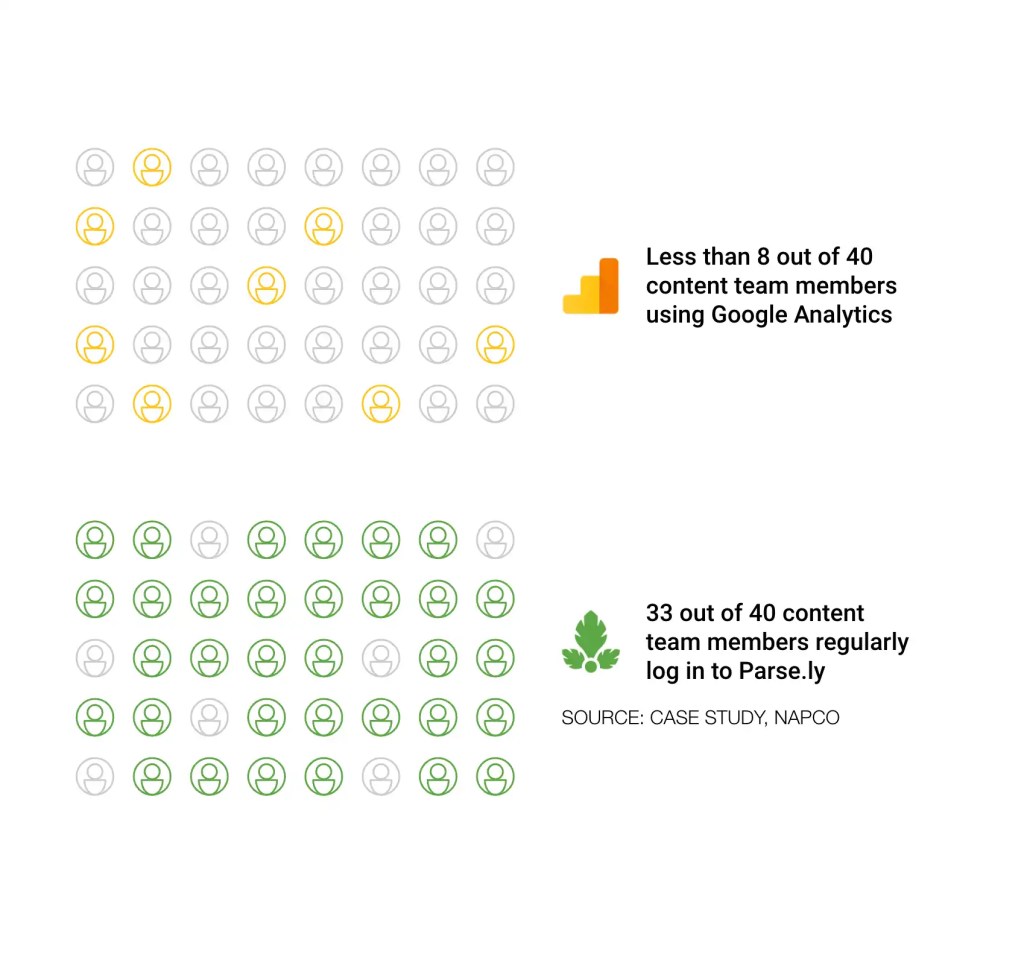Results
- Growing from only 8 out of 40 editors using Google Analytics to 33 out of 40 editors using Parse.ly.
- In other words, making data-driven practices accessible and desirable for the whole organization.

In 2015, Dave Leskusky, president at NAPCO Media, took a look at the media company’s overall corporate structure and realized that there was a disconnect between the content his team was producing, its audience development strategies, and its approach to sales.
The biggest disconnect? The company considered ad revenue to be paramount; content was secondary. Leskusky knew that he had to change that perception to grow as a serious player in the digital media space.
He knew he’d have to get buy-in from a team used to focusing on ads. Leskusky thought a focus on analytics could help the staff shift to putting content, and readers, first. As it was, editors used Google Analytics to measure their audience. However, the data found in there was not incorporated into NAPCO’s content strategy or culture.
“In the past, we didn’t always know when something resonated with our audience. In print, there is no feedback mechanism…unless you make a mistake. Then you get hate mail. But, when things are good, you don’t get much feedback.”
David Leskusky, President, NAPCO Media
That left some editors pulling data from the tool, and some were not. Leskusky saw the need to provide his staff with a better way to make informed decisions about content based on data.
That’s when Leskusky read an article by Parse.ly CEO Sachin Kamdar in one of his company’s own publications, Publishing Executive, about how publishers are using analytics. The article struck a nerve as he realized that his editors were guessing at what readers wanted to read. He set up a call with Parse.ly and NAPCO brought the analytics dashboard to the organization, along with a goal of empowering their content creators through data about the readers.
Empowering NAPCO’s newsroom with digestible insights
Editors at NAPCO Media describe the Parse.ly dashboard as “digestible.” They appreciate the clear interface and the fact that it is virtually unbreakable — they can just log in and start poking around for insights, with no fear of messing up someone else’s set-up.
“Parse.ly allows us to get immediate feedback regarding what resonates with our audiences, and what doesn’t. This is something our editors really care about, and finally they have a way to access that information.”
David Leskusky, President, NAPCO Media
This accessibility has allowed them to embrace a culture where interaction with their readers doesn’t end when they hit “publish,” instead it’s just beginning. The company adopted a goal of using analytics to cultivate communities and increased engagement among readers, all based on data that they could actually understand and use.
This starts at the top: executives use Parse.ly’s network overview to see the entire audience across every title — extending to their freelancers who can see their own stories and track their audience, without having to worry about giving away full company data, through Parse.ly’s shareable links.
“I’ve become a Parse.ly evangelist. I was telling a friend about Parse.ly and this person asked, “Well is it the carrot or the stick?” My reply was that Parse.ly is more like the candy bar I should really put down, but I just can’t stop checking on it…”
Melissa Ward, Senior Content/Managing Editor Target Marketing, NAPCO Media
Using data to monetize
Leskusky says, “Knowing what is resonating with your audience should allow you to monetize.” He sees Parse.ly as a powerful tool to help NAPCO close future deals. By providing his sales team with access to the Parse.ly dashboard, he is confident they will be able to derive insights on the overall marketplace. For example, NAPCO produces a variety of e-learning events, including webinars, virtual shows, etc., and the topics that are trending in Parse.ly are great fodder for these events.
Additionally, NAPCO can plug Parse.ly data into its data warehouse to better understand who is reading articles about specific topics. It can then promote relevant events to these people, given their initial interest.
The new reporting cycle used at NAPCO
Report & Create: Use data on previous stories, posts or articles to help identify topics your audience responded well to before.
Package & Distribute: When’s the best time to share on Facebook? Should you add a video in? Make sure you track and analyze how your decisions about layout or platforms affect the audience.
Assess & Participate: Everything published online starts a conversation with readers; make sure that you know what they’re saying by tracking referrals, social media reactions, and more.
Amplify: The more comfortable you get with data, the more you can intuitively use it to create successful strategies and make decisions that grow, engage, and connect with your readers.